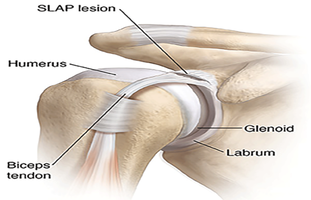A Real Case: Managing an MRI Diagnosis as a Physiotherapist
When encountering an MRI result like this, what actions can a physiotherapist take?
Partial rupture of the superior glenoid labrum with involvement of the anterior portion suggestive of a possible SLAP lesion, accompanied by an adjacent fluid collection with a reactive appearance, cystic in nature, measuring approximately 11×6 mm, initially attributable to a paralabial cyst. Normal insertion of the bicipital labrum and the tendons of the long head of the biceps brachii.
Let’s Break it down first:
Partial rupture of the superior glenoid labrum with involvement of the anterior portion suggestive of a possible SLAP lesion:
A tear in the cartilage lining the shoulder joint, known as the labrum, has occurred. Specifically, the tear is situated in the upper part (superior) and extends toward the front (anterior) of the shoulder, indicating a SLAP lesion (Superior Labrum Anterior to Posterior lesion).
Accompanying an adjacent fluid collection with a reactive appearance, cystic in nature, measuring approximately 11×6 mm, initially attributable to a paralabial cyst:
Initially attributed to a paralabial cyst, this suggests a small fluid-filled sac near the tear, likely caused by the labrum tear.
Normal insertion of the bicipital labrum and the tendons of the long head of the biceps brachii:
This means that the biceps tendon, which is a muscle that helps to flex the arm, is still attached to the labrum and is functioning normally.
Here is a diagram of a SLAP lesion:
Causes and symptoms
SLAP lesions are typically caused by overuse or trauma to the shoulder.
The most common symptoms of a SLAP lesion are pain in the shoulder, especially when throwing or lifting overhead, and weakness in the shoulder.
Treatment for SLAP lesions depends on the severity of the tear.
In some cases, non-surgical treatment, such as rest, physical therapy, and pain medication, may be enough to relieve symptoms. In other cases, surgery may be necessary to repair the tear.
what would be a physiotherapy treatment plan?
A physiotherapy treatment plan for a SLAP lesion with a paralabral cyst will typically involve a combination of range of motion exercises, strengthening exercises, and pain relief techniques. The specific exercises and techniques used will vary depending on the severity of the tear and the size and location of the cyst.
Range of motion exercises
Range of motion exercises are designed to improve flexibility and reduce pain. These exercises may include gentle stretching of the shoulder muscles and joint, as well as passive range of motion exercises that are performed by a therapist.
Strengthening exercises
Strengthening exercises are designed to strengthen the muscles around the shoulder joint, which can help to stabilize the joint and reduce pain. These exercises may include isometric exercises, which involve contracting the muscles without moving the joint, as well as dynamic exercises which involve moving the joint through a range of motion.
Pain relief techniques
Pain relief techniques may include ice, heat, massage, and transcutaneous electrical nerve stimulation (TENS).
The cyst may affect the physiotherapy treatment plan in a few ways. If the cyst is large or causing pressure on surrounding nerves, it may need to be drained before other treatment can begin. In some cases, the cyst may shrink or disappear with physiotherapy treatment.
Here is a general overview of a physiotherapy treatment plan for a SLAP lesion with a paralabral cyst:
- Initial phase: Focus on pain relief and reducing inflammation. This may involve rest, ice, pain medication, and TENS.
- Intermediate phase: Begin range of motion exercises to improve flexibility. These exercises may be gentle and passive at first, but they will gradually become more active and dynamic.
- Advanced phase: Focus on strengthening exercises to strengthen the muscles around the shoulder joint. These exercises will help to stabilize the joint and reduce pain.
The length of time it takes to complete a physiotherapy treatment plan for a SLAP lesion with a paralabral cyst will vary depending on the severity of the tear and the size and location of the cyst. However, most people will see significant improvement within a few months.
It is important to follow your physiotherapist’s instructions carefully and to continue with the exercises as prescribed. This will help you to achieve the best possible outcome.



